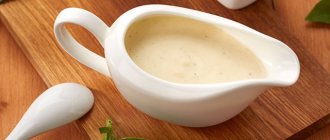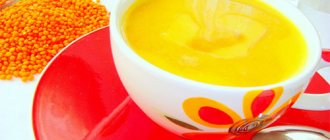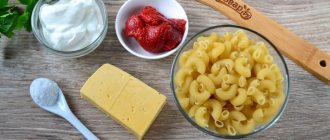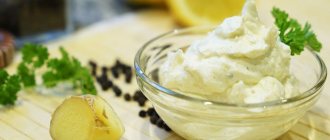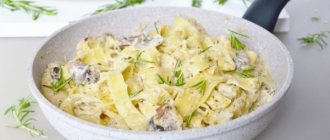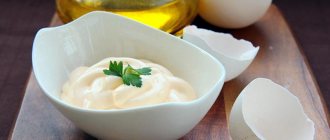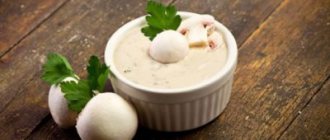What is usually included in Bolognese sauce?
There is no single recipe for Italian bolognese sauce. Ratios vary, but the main ingredients remain the same. He contains:
- onion;
- celery;
- carrot;
- chopped meat;
- tomatoes;
- milk;
- White wine.
Onions, celery and carrots
A combination of finely diced onions, celery and carrots, sauteed in olive oil and seasoned with salt and pepper, is called soffritto in Italian cooking. It is the basis of many dishes in Italy, including Bolognese sauce.
The onions, celery and carrots are cut into 0.5 x 0.5 cm pieces. The uniformity of the soffritto means that the ingredients will cook evenly and create a more pleasant texture in the finished sauce.
Chopped meat
Traditionally, Bolognese sauce is made from minced beef, less often from pork. It is better to use low-fat minced meat. Some versions of the recipes often include several types of minced meat, including chicken.
A successful combination is obtained from minced meat of three types, taken in equal parts:
- Veal - rich in gelatin, but weakly flavored. Gives the finished sauce a silky, smooth texture.
- Pork is high in fat and has a weak flavor. Emulsifies well in the finished sauce.
- Lamb has a rich flavor but a fairly rough texture.
Combining these types of minced meats results in a flavorful, rich, and silky Bolognese sauce.
Tomatoes
Surprisingly, tomatoes are NOT the main ingredient in Italian Bolognese sauce. The authentic recipe is very different from the bright red tomato sauce that most of us have tried. It's more of a meaty, rich, creamy sauce. Italian Bolognese contains a small amount (relative to volume) of tomatoes, as it remains primarily a meat sauce.
You can use diced or pureed tomatoes. For a Bolognese recipe, it is not necessary to choose smooth and beautiful fruits.
If you have canned whole tomatoes, puree them using a hand mixer, blender or food processor.
Milk
Most of us aren't used to adding milk to meat sauces, but in bolognese it's the ingredient that adds richness and tenderizes the meat.
It also changes color, becoming more orange than red. Use whole milk (3.2%) or partially skimmed (2%).
Seasonings
The classic Bolognese sauce recipe contains almost no aromatic herbs or spices. Only bay leaf, nutmeg or red pepper flakes are added, but most often the only seasonings are salt and black pepper.
Spaghetti with Bolognese sauce
What to take:
- minced meat – 0.6 kg;
- garlic – 2 cloves;
- canned tomatoes – 0.5 kg;
- one onion;
- black pepper to taste;
- spaghetti – 0.25 kg;
- salt to taste;
- cheese – 40 g;
- a handful of fresh parsley;
- sweet pepper – 2 pcs.;
- oregano and basil to taste;
- olive oil – 30 ml.
How to prepare Bolognese pasta:
- Finely chop the peeled garlic and onion and start frying with olive oil.
- After 4 minutes, add the bell pepper, cut into cubes.
- Add minced meat and fry it with vegetables for about 10 minutes.
- Grind the tomatoes in a blender and pour the resulting sauce into the frying pan.
- Pour in all the spices and salt, simmer the mixture for 20 minutes under the lid.
- 10 minutes after the start of stewing, we start cooking the spaghetti. We do not boil them until fully cooked - they will “cook” later, in a frying pan with sauce. We wash the finished pasta.
- Finely chop fresh parsley and cheese.
- Combine the prepared spaghetti with Bolognese, crumble cheese and parsley on top. Bon appetit!
Classic Italian Bolognese sauce recipe
You can simply mix ground beef with tomato paste, fry it and call the dish “Bolognese sauce.” But there is a certain, completely unique taste that can only be achieved if you follow the classic cooking recipe exactly and step by step. Real bolognese sauce takes several hours to prepare. It gets better the longer you cook it, so don't rush it.
- Yield: 12-15 servings
- Per 1 serving: calorie content – 367 calories, fat – 10.6 g, cholesterol – 54.9 mg, sodium – 391.6 mg, carbohydrates – 48.5 g, fiber – 5.9 g, sugar – 9.3 g , protein – 22.7 g.
Ingredients:
- 1 tbsp. l. butter;
- 1 tbsp. l olive oil;
- 1 large carrot, finely diced;
- 1 medium-sized white onion, finely chopped;
- 1 stalk of celery, cut into cubes;
- 6 cloves garlic, minced in a garlic press;
- 500 g minced beef;
- 400 g fresh tomatoes, diced or chopped in a food processor;
- 1 glass of whole milk;
- 0.5 tbsp. dry white wine (eg Chardonnay);
- 0.5 tbsp. beef broth;
- juice of one lemon;
- a pinch of nutmeg;
- 2 bay leaves;
- salt and pepper to taste;
- parmesan cheese for serving.
How to make bolognese sauce step by step:
- Preheat the oven to 200ºC.
- Place the tomatoes on a baking sheet, drizzle with oil and salt.
- Bake in the oven for 20 minutes or until tender and crispy.
- Remove the tomatoes and set aside.
- Once cooled, puree them in a blender to make tomato sauce.
- Heat a deep frying pan over medium heat, pour in the vegetable oil and immediately add the butter. Once melted, add carrots, celery and onion.
- Stir-fry until the vegetables are soft, about 5 minutes.
- Add garlic and simmer for another minute.
- Add ground beef to skillet and stir in roasted vegetables.
- Once the meat is cooked, start adding all the other ingredients.
- Stir and simmer for 2-3 hours over low heat.
- Remove the bay leaf and serve the prepared Bolognese sauce with pasta and grated Parmesan cheese.
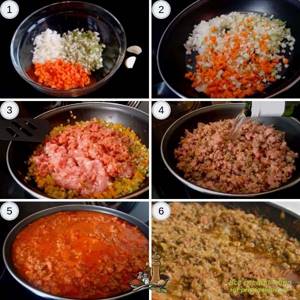
Origin of the sauce
salsa alla bolognese as it is called in Italy , is named after the city in which it was invented by the Italian writer Pellegrino Artusi in Bologna , in the Emilia-Romagna region. Pellegrino described this meat sauce in his cookbook published in 1891, but the first mention of a traditional meat sauce served with pasta dates back to the 19th century and the very first recipe for such a stew is documented in the city of Imola, also near Bologna.
When talking about pasta and Bolognese sauce, the most popular dish that immediately comes to mind is spaghetti bolognese . Despite its wide distribution throughout the world, this dish is not traditional. Italians mix Bolognese sauce only with tagliatelle . And spaghetti Bolognese is considered an unsuccessful attempt by foreigners to copy the original dish.
One of the versions of the origin of this dish dates back to the period of the Second World War, when English soldiers tried the sauce in Italy and wanted to recreate it when they returned home. But they used the more common and more “Italian” spaghetti as pasta.
In addition, the famous Italian gastronomic journalist Stefano Bonilli has repeatedly pointed out in his articles and speeches that spaghetti can have nothing in common with Bolognese sauce, if only because the dish comes from northern Italy . Where tagliatelle is mainly used as pasta, and spaghetti belongs to the southern part of Italy.
The use of tagliatele instead of spaghetti is also practical . If you have often tried spaghetti alla Bolognese in restaurants, you have probably noticed that after you eat the spaghetti, a good half of the stew remains on the plate. This is why flat, wide tagliatelle is great for this sauce, because the meat ragu sticks much better to such pasta than to spaghetti.
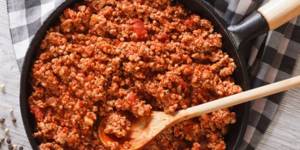
Bolognese sauce
The classic recipe beef, pork, tomato paste, wine, onion, and cream to prepare the sauce . But, as often happens, along with the classic one, there are many other variations of the recipe: canned tomatoes, sweet peppers and a wide variety of spices are added to Bolognese.
The sauce has spread so widely around the world and has become stronger in different variations in the minds of chefs that it eventually became difficult to determine the original traditional recipe for Bolognese sauce. The Italian Academy of Cuisine (Accademia Italiana della Cucina, Italian) even had to intervene and, together with the Bologna Chamber of Commerce (La Camera di Commercio di Bologna, Italian), approved the ingredients of the traditional recipe: beef, pork, pancetta , onions, carrots, celery, tomatoes, meat broth, dry white wine, milk .
Despite this, many cooks distort the recipe by excluding key ingredients or adding completely unnecessary ingredients. For example, the sauce is often prepared with one type of meat - beef, which is usually tough and fatty, which makes the paste itself just as unpleasant to eat. Extra ingredients are also added to the sauce in the form of aromatic herbs: oregano, basil, parsley, rosemary and sage. By the way, no garlic is added to the sauce either .
The worst insult for any Italian cook who is sensitive to this recipe would be the use not so much of inappropriate herbs as the use of a dry mixture of Italian herbs.
There is nothing worse than such a sauce mixture, because bolognese must have a strictly defined taste, and the herbs must be full-fledged ingredients that complement the dish.
Instructions for making bolognese sauce in a slow cooker
If you are making bolognese sauce in a slow cooker, reduce the amount of liquid used in the classic recipe:
- 0.5 tbsp. milk;
- 200 g diced or crushed tomatoes;
- ¼ cup beef broth.
You also need to add 60 ml of tomato paste. It is necessary to enhance the taste of tomatoes, which will be lost from the slow process of boiling and thickening in a slow cooker.
All other ingredients are the same as in the classic stove top recipe.
How to do:
- Heat butter and vegetable oil in a slow cooker and stir until butter melts.
- Add onion, carrots, celery, garlic and ½ teaspoon salt and cook on LOW for 5 minutes.
- Pour in the milk and tomatoes, beef broth, tomato paste and a little ground black pepper. (Do not add more salt at this point; wait until cooking is complete to taste and adjust saltiness if necessary.) Cover and cook on SAUTE for about 6 hours.
- If the sauce still seems thick and thin after this period of time, continue cooking for about 2 hours, or remove the lid and simmer on low for about 30 minutes or until the desired consistency is reached.
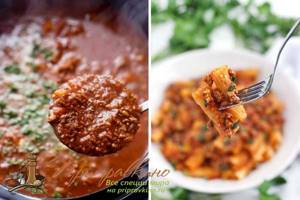
Traditional Italian sauce
List of recipe ingredients:
- onion – 1 pc.;
- meat broth - 0.2 l;
- red wine – 150 ml;
- bacon – 80 g;
- tomato paste – 0.8 kg;
- beef meat – 250 g;
- olive oil – 30 ml;
- pork – 250 g;
- fresh celery – 70 g;
- garlic clove – 2 pcs.;
- carrot – 1 pc.;
- butter – 40 g.
How to make Bolognese sauce:
- Process all vegetables by peeling and washing them. Chop the carrots into cubes, and cut the celery, onion and garlic cloves into small slices.
- Place both types of oil on the surface of the frying pan and heat them. Add garlic and onion and sauté until transparent.
- Add carrots and celery pieces and cook for another 5 minutes.
- After this, pour the bacon pieces into the pan, stir and fry for 5 minutes.
- We make minced meat from pork and beef and add it to the ingredients being prepared.
- Sauté until the minced meat turns brown and add 100 ml of wine.
- After the alcohol has evaporated, pour in the meat broth.
- Add tomato paste to the sauce, close the lid and simmer the dish for an hour.
- Stir the sauce constantly. It will be ready as soon as the meat is soft and the vegetable pieces are completely cooked.
Description of preparation:
Below I will give a step-by-step description of how to make bolognese without meat.
If canned tomatoes are too sour, you can add a spoonful of any sweetener. This will balance the taste. If desired, finely chopped champignons can be added to the bolognese. I like this particular option because it is simple, made from affordable ingredients and contains a lot of protein. The Bolognese turns out juicy, filling and very tasty! Purpose: For dinner Main ingredient: Vegetables / Legumes / Pasta / Lentils Dish: Sauces / Hot dishes / Pasta Geography of cuisine: Italian / European Diet: Lenten dishes / Vegan dishes
How to prepare “Sauce a la Bolognese”
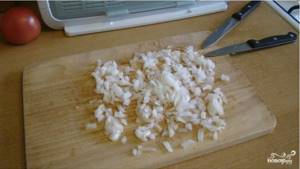
Finely chop the onion. The smaller the pieces, the tastier and more uniform the sauce will be.
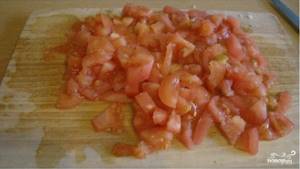
Pour boiling water over the tomatoes and remove the skins. Cut the tomatoes into small cubes.
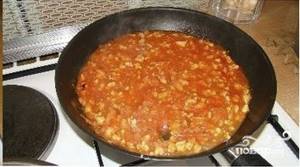
Add minced meat to a heated frying pan with oil. Fry it for a few minutes. Then add the onion and fry for another 1-2 minutes. Add tomatoes and simmer until sauce is smooth. You can add a spoonful of tomato paste for color. Add salt to the sauce and remove from heat. Add finely chopped garlic to the sauce.
Recipes
Classic pasta bolognese recipe (spaghetti with minced meat)
If you are looking for the simplest and most affordable Bolognese recipe, then use this option. Essentially, it’s just spaghetti with minced meat and a very tasty tomato sauce, ala Bolognese. Far from the “original”, but still very, very tasty. Just look at this beauty!
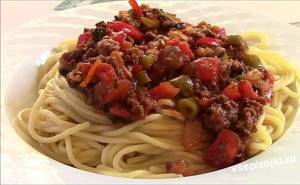
Since this is a homemade recipe that does not pretend to be traditional, you can supplement this stew with any other vegetables and spices if you wish.
Ingredients:
- Minced meat – 420 g.
- Onions – 2 pcs.
- Sweet pepper – 3 pcs.
- Tomatoes in juice – 250-300 g.
- Parsley – 1 small bunch;
- Garlic – 3 cloves;
- Salt – a few pinches;
- Black pepper - to taste;
- Vegetable oil;
- A pack of spaghetti or any other pasta;
Cooking classic pasta bolognese recipe at home
First, peel and finely chop the onion. Onions can be taken either white or red (blue).

Wash the bell pepper, remove the seeds, then also cut into small pieces.
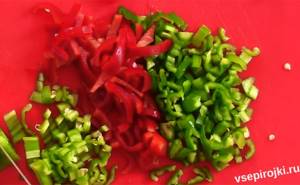
Heat a small amount of vegetable oil in a frying pan and add the onion. Cook over medium heat, stirring occasionally, until the onion begins to yellow. At this point, add the minced meat to the onion.
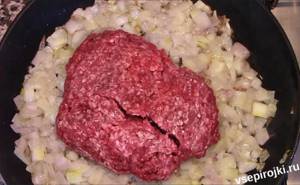
Continue frying over low heat, stirring and breaking up lumps of minced meat with a spatula. When the minced meat turns brown, add chopped bell peppers to it.
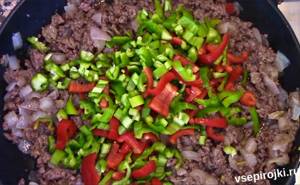
Add salt, pepper, and squeeze or grate the garlic cloves here. Add tomatoes and mix well. Continue simmering for 5 minutes.
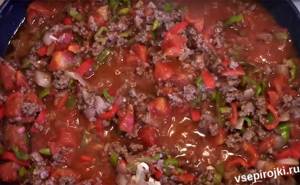
Finely chop the parsley, then add it to the stew. Stir and simmer until the vegetables are ready (the minced meat should be completely cooked by then). You can cover it with a lid. Don't forget to come back and stir from time to time.
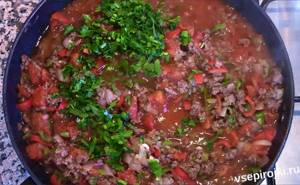
While our tomato and minced meat sauce is being prepared, you need to cook the spaghetti. Boil water in a saucepan and add salt. Lay out the required amount of pasta, cook until it is ready (see the packaging for details, since spaghetti varies in thickness, type of wheat, etc.).
That's it, put some spaghetti on a plate and generously cover it with Bolognese sauce. Decorate with fresh herbs or grated cheese (it will just melt while everything is hot).
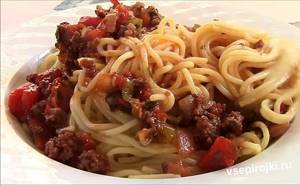
I would like to recommend you some more simple meat dishes. Here we have stewed chicken with cabbage, and here we have magnificent chicken legs in the oven. Simple and original, but at the same time very tasty recipes.
Pasta Bolognese recipe is classic, almost Italian
This option is quite close to the classic Bolognese, and many even consider this dish to be “truly Italian.” In fact, this is an American variation of Bolognese, also known as “spaghetti ala Bolognese.”
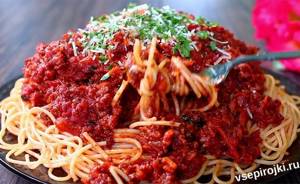
This dish appeared in the USA, among Italian migrants. The original Bolognese recipe has undergone changes, greatly simplified, and the result is such a tasty and beautiful execution.
We will need:
- Minced meat (pork or beef) – 450 g.
- Carrots – 3 small;
- Petiole celery - 3 stalks;
- Tomatoes in juice (pieces) – 430 g.
- Onions – 1 pc.
- Tomato paste – 100-150 g (optional);
- Red wine – 50-70 ml.
- Butter (or vegetable oil) – 3 tbsp. spoons;
- Garlic – 3 cloves;
- Italian seasoning (in a bag) – 1 teaspoon;
- Nutmeg – 2 pinches (to taste);
- Salt - to taste;
- Pasta – 400-500 g.
- Parmesan cheese - optional;
- Greens - optional;
Classic pasta bolognese recipe how to cook?
Melt a small piece of butter in a frying pan, then add all the minced meat there.
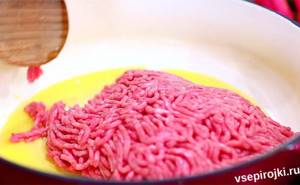
Fry over medium heat, stir well with a spatula so that the minced meat does not stick together. Fry until the color changes as in the photo below.
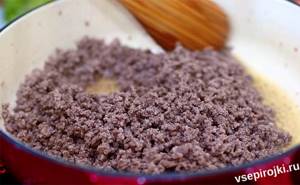
In the meantime, peel, rinse and finely chop the onion, carrots and celery. If desired, you can grate celery and carrots on a fine grater.
Add all the chopped vegetables to the minced meat, then mix well and leave to simmer for 10-15 minutes until the carrot pieces become softer.
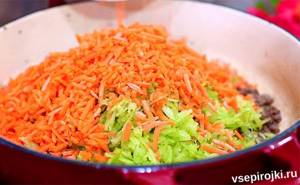
Add salt, seasonings, squeeze out the garlic and pour about 50-80 ml. guilt. Some use red wine, others white. There are heated debates here, we don’t need them, so add the wine that suits your taste.
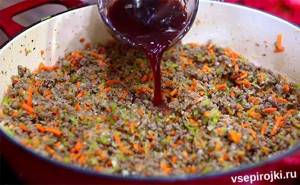
Stir, simmer for 5-10 minutes, then add tomatoes to this pan. Tomatoes must be peeled and chopped. You can also add a few tablespoons of tomato paste to the tomato mass.
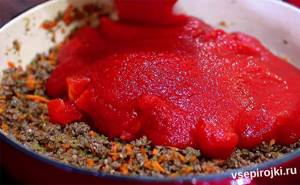
The American version of Bolognese contains a larger amount of tomato sauce, and, as a result, the stew itself turns out brighter, more red.
Simmer and stir occasionally. All ingredients should be well cooked and soft.
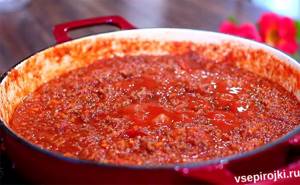
Now chop fresh herbs, it could be parsley, basil, cilantro. Add it to the sauce, mix well and leave to simmer for another 5-10 minutes.
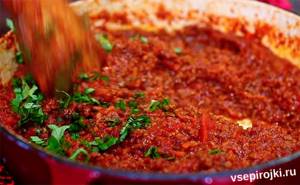
By then you should have cooked and cooled the spaghetti. Don’t forget to rinse the pasta with water after cooking so that it doesn’t stick together later.
Place the spaghetti in a large bowl and add a couple of spoons of bolognese. Mix thoroughly. Now grate the cheese on a fine grater and mix again. That's it, now you can put it into portions.
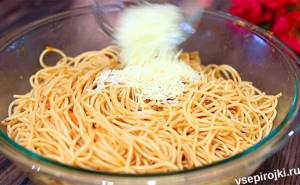
Generously spread freshly prepared sauce with minced meat on top of the spaghetti; you can additionally decorate with cheese and chopped herbs.
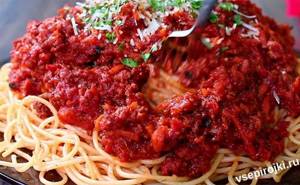
And here is a video with a similar preparation option
Classic Bolognese pasta recipe (Italian)
And now we have come to a recipe that can be safely considered, if not original, then certainly classic. This is exactly what the residents of Bologna traditionally prepare.
Here we have pancetta, and long cooking, and the use of milk, and long stewing, during which the minced meat acquires a delicate consistency. Well, how can we not mention the use of a special pasta - tagliatelle. Let's not waste time, let's get straight to cooking!
We need:
- Chopped pork and beef (minced meat) – 400 g.
- Carrots – 2 pcs.
- Celery – 2 sticks;
- Onions – 1 pc.
- Red wine – 130 ml.
- Milk (or cream 10-15%) – 130 ml.
- Puree tomatoes in their juice (passata sauce) – 110 ml.
- Butter – 50 g.
- Pancetta (or just bacon) - several thin slices;
- Salt and black pepper - a few pinches each;
Pasta Bolognese recipe. Calorie, chemical composition and nutritional value.
Nutritional value and chemical composition of “Bolognese pasta”.
The table shows the nutritional content (calories, proteins, fats, carbohydrates, vitamins and minerals) per 100 grams of edible portion.
| Nutrient | Quantity | Norm** | % of the norm in 100 g | % of the norm in 100 kcal | 100% normal |
| Calorie content | 170.8 kcal | 1684 kcal | 10.1% | 5.9% | 986 g |
| Squirrels | 7.6 g | 76 g | 10% | 5.9% | 1000 g |
| Fats | 5 g | 56 g | 8.9% | 5.2% | 1120 g |
| Carbohydrates | 22.1 g | 219 g | 10.1% | 5.9% | 991 g |
| Alimentary fiber | 1.8 g | 20 g | 9% | 5.3% | 1111 g |
| Water | 63.3 g | 2273 g | 2.8% | 1.6% | 3591 g |
| Ash | 0.246 g | ~ | |||
| Vitamins | |||||
| Vitamin B1, thiamine | 0.025 mg | 1.5 mg | 1.7% | 1% | 6000 g |
| Vitamin B2, riboflavin | 0.017 mg | 1.8 mg | 0.9% | 0.5% | 10588 g |
| Vitamin B5, pantothenic | 0.121 mg | 5 mg | 2.4% | 1.4% | 4132 g |
| Vitamin B6, pyridoxine | 0.04 mg | 2 mg | 2% | 1.2% | 5000 g |
| Vitamin B9, folates | 5.04 mcg | 400 mcg | 1.3% | 0.8% | 7937 g |
| Vitamin E, alpha tocopherol, TE | 0.031 mg | 15 mg | 0.2% | 0.1% | 48387 g |
| beta tocopherol | 0.014 mg | ~ | |||
| gamma tocopherol | 0.246 mg | ~ | |||
| Vitamin RR, NE | 0.476 mg | 20 mg | 2.4% | 1.4% | 4202 g |
| Macronutrients | |||||
| Potassium, K | 62.44 mg | 2500 mg | 2.5% | 1.5% | 4004 g |
| Calcium, Ca | 7.08 mg | 1000 mg | 0.7% | 0.4% | 14124 g |
| Magnesium, Mg | 15.11 mg | 400 mg | 3.8% | 2.2% | 2647 g |
| Sodium, Na | 1.92 mg | 1300 mg | 0.1% | 0.1% | 67708 g |
| Sera, S | 36.78 mg | 1000 mg | 3.7% | 2.2% | 2719 g |
| Phosphorus, Ph | 52.9 mg | 800 mg | 6.6% | 3.9% | 1512 g |
| Chlorine, Cl | 0.37 mg | 2300 mg | 621622 g | ||
| Microelements | |||||
| Iron, Fe | 0.364 mg | 18 mg | 2% | 1.2% | 4945 g |
| Manganese, Mn | 0.2572 mg | 2 mg | 12.9% | 7.6% | 778 g |
| Copper, Cu | 81.08 mcg | 1000 mcg | 8.1% | 4.7% | 1233 g |
| Molybdenum, Mo | 0.427 mcg | 70 mcg | 0.6% | 0.4% | 16393 g |
| Selenium, Se | 17.696 mcg | 55 mcg | 32.2% | 18.9% | 311 g |
| Fluorine, F | 26.67 mcg | 4000 mcg | 0.7% | 0.4% | 14998 g |
| Zinc, Zn | 0.3948 mg | 12 mg | 3.3% | 1.9% | 3040 g |
| Digestible carbohydrates | |||||
| Starch and dextrins | 17.486 g | ~ | |||
| Mono- and disaccharides (sugars) | 0.7 g | max 100 g | |||
| Glucose (dextrose) | 0.034 g | ~ | |||
| Maltose | 0.549 g | ~ | |||
| Sucrose | 0.134 g | ~ | |||
| Fructose | 0.031 g | ~ | |||
| Essential amino acids | |||||
| Arginine* | 0.133 g | ~ | |||
| Valin | 0.165 g | ~ | |||
| Histidine* | 0.083 g | ~ | |||
| Isoleucine | 0.143 g | ~ | |||
| Leucine | 0.277 g | ~ | |||
| Lysine | 0.083 g | ~ | |||
| Methionine | 0.041 g | ~ | |||
| Threonine | 0.129 g | ~ | |||
| Tryptophan | 0.052 g | ~ | |||
| Phenylalanine | 0.187 g | ~ | |||
| Nonessential amino acids | |||||
| Alanin | 0.123 g | ~ | |||
| Aspartic acid | 0.175 g | ~ | |||
| Glycine | 0.123 g | ~ | |||
| Glutamic acid | 1.287 g | ~ | |||
| Proline | 0.439 g | ~ | |||
| Serin | 0.173 g | ~ | |||
| Tyrosine | 0.068 g | ~ | |||
| Cysteine | 0.071 g | ~ | |||
| Saturated fatty acids | |||||
| Saturated fatty acids | 0.1 g | max 18.7 g | |||
| 16:0 Palmitinaya | 0.07 g | ~ | |||
| 18:0 Stearic | 0.007 g | ~ | |||
| Monounsaturated fatty acids | 0.048 g | min 16.8 g | 0.3% | 0.2% | |
| 18:1 Oleic (omega-9) | 0.048 g | ~ | |||
| 18:1 cis | 0.048 g | ~ | |||
| Polyunsaturated fatty acids | 0.158 g | from 11.2 to 20.6 g | 1.4% | 0.8% | |
| 18:2 Linolevaya | 0.151 g | ~ | |||
| 18:3 Linolenic | 0.007 g | ~ | |||
| 18:3 Omega-3, alpha-linolenic | 0.007 g | ~ | |||
| Omega-6 fatty acids | 0.2 g | from 4.7 to 16.8 g | 4.3% | 2.5% |
The energy value of Pasta Bolognese is 170.8 kcal.
Primary Source: Created in the application by the user. Read more.
** This table shows the average levels of vitamins and minerals for an adult. If you want to know the norms taking into account your gender, age and other factors, then use the “My Healthy Diet” application.
Ingredients:
- Minced meat – 1 kilogram (beef + pork)
- Onion - 2 pieces
- Celery pod - 1 piece (small stalk)
- Carrots – 2 pieces
- Garlic - 2-3 cloves
- Tomatoes in their own juice - 1 glass
- Tomato paste - 1 Cup
- Dry red wine – 1 glass
- Olive oil - To taste
- Butter - 1 teaspoon
- Salt, sugar and pepper - To taste
- Bay leaf – 1 piece
Number of servings: 3
Spaghetti bolognese
This recipe is closest to the classic version of preparing spaghetti Bolognese.
Ingredients:
- spaghetti – 500 gr.,
- veal – 400 gr.,
- pork – 300 gr.,
- onions – 2 heads,
- celery stalk – 100 gr.,
- carrots – 1 pc.,
- garlic – 3 cloves,
- olive oil – 40 gr.,
- milk cream – 150 ml,
- beef broth – 250 ml,
- butter – 50 gr.,
- dry white wine – 150 ml,
- tomatoes – 2 pcs.,
- dry herbs (basil, oregano) – 5 g.,
- black pepper, salt to taste.
Cooking process:
Rinse the meat, dry with a paper towel, cut into cubes and pass through a meat grinder. Peel the onion and cut into small cubes. Chop the celery stalk and grate the carrots on a fine grater. Pour boiling water over the tomatoes, remove the skins and grind into puree. Chop the garlic as finely as possible. Pour olive oil into a deep saucepan, melt the butter and sauté the onion and garlic until transparent. Add carrots and celery and fry for a few minutes. Place the minced meat and tomato puree in a saucepan with the vegetables and simmer, breaking up any lumps with a spatula, for 15 minutes. Then pour in the wine and wait until it evaporates. Sprinkle the sauce with spices, pour in the cream and broth, stir and cover with a lid. Simmer over low heat for 5-10 minutes.
Now you should start cooking spaghetti. To do this, bring 1.5 liters of clean water to a boil with the addition of salt and 1 tablespoon of olive oil. Place the pasta in the pan and bring to a boil again. It is important not to overcook the spaghetti, so 7-8 minutes will be enough to cook it. Then drain the pasta in a colander and rinse with clean water. Place spaghetti on a flat serving plate and pour Bolognese sauce on top.
